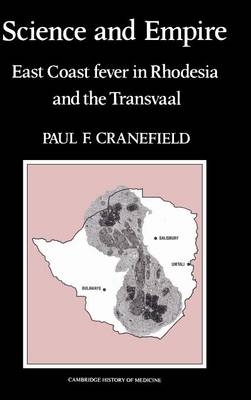
Science and Empire
East Coast Fever in Rhodesia and the Transvaal
Seiten
1991
Cambridge University Press (Verlag)
978-0-521-39253-2 (ISBN)
Cambridge University Press (Verlag)
978-0-521-39253-2 (ISBN)
East Coast fever can kill 95% of a herd of cattle in three weeks. The disease was unknown to western science until it was introduced into Rhodesia in 1901. This book describes the social and economic impact, the scientific investigations into it, and the effort to control it.
East Coast fever is a lethal disease of cattle, caused by a parasite that multiplies within T-lymphocytes, causing them to become lymphoblasts that behave like cells in leukaemia and lymphoma. This is the story of the disease and its effects on farmers, as well as of the scientists who studied it. The disease was unknown to western science or to veterinary practice until it was introduced into Rhodesia in 1901. It devastated the cattle-raising and ox-cart dependent transport systems of Rhodesia and South Africa and was not fully brought under control for some 50 years. The book describes the social and economic impact of the outbreak, the scientific investigations into it, and the effort to control it. The scientific study of the disease was done in part by the famous bacteriologist Robert Koch, whose many early errors had a negative effect on later investigators whose work was far more sound.
East Coast fever is a lethal disease of cattle, caused by a parasite that multiplies within T-lymphocytes, causing them to become lymphoblasts that behave like cells in leukaemia and lymphoma. This is the story of the disease and its effects on farmers, as well as of the scientists who studied it. The disease was unknown to western science or to veterinary practice until it was introduced into Rhodesia in 1901. It devastated the cattle-raising and ox-cart dependent transport systems of Rhodesia and South Africa and was not fully brought under control for some 50 years. The book describes the social and economic impact of the outbreak, the scientific investigations into it, and the effort to control it. The scientific study of the disease was done in part by the famous bacteriologist Robert Koch, whose many early errors had a negative effect on later investigators whose work was far more sound.
List of illustrations; Preface; Acknowledgments; 1. Prologue; 2. The places and the players; 3. A new disease?; 4. The search for an expert; 5. Robert Koch in Bulawayo; 6. Joseph Chamberlain; 7. Arnold Theiler, Charles Lounsbury and Duncan Hutcheon; 8. The fight against East Coast fever; 9. The African-owned cattle in Rhodesia; 10. Two more parasites and another new disease; 11. What is East Coast fever?; 12. Epilogue; Notes and references; Index.
| Erscheint lt. Verlag | 22.2.1991 |
|---|---|
| Reihe/Serie | Cambridge Studies in the History of Medicine |
| Verlagsort | Cambridge |
| Sprache | englisch |
| Maße | 152 x 229 mm |
| Gewicht | 760 g |
| Themenwelt | Studium ► Querschnittsbereiche ► Geschichte / Ethik der Medizin |
| ISBN-10 | 0-521-39253-5 / 0521392535 |
| ISBN-13 | 978-0-521-39253-2 / 9780521392532 |
| Zustand | Neuware |
| Haben Sie eine Frage zum Produkt? |
Mehr entdecken
aus dem Bereich
aus dem Bereich
Die Geschichte eines Weltzentrums der Medizin von 1710 bis zur …
Buch | Softcover (2021)
Lehmanns Media (Verlag)
CHF 27,90
von der Antike bis zur Gegenwart
Buch | Softcover (2024)
C.H.Beck (Verlag)
CHF 16,80
Krankheitslehren, Irrwege, Behandlungsformen
Buch | Softcover (2024)
C.H.Beck (Verlag)
CHF 55,90


